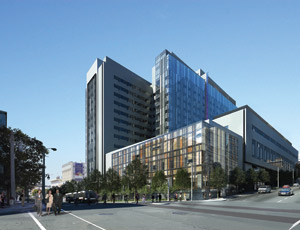Engineering and architectural firms took some hits last year, as ENR California’s Top Design Firms ranking indicates, but a big-picture look at the data provides some reason for optimism.

California revenue for major design firms declined just 1.2% in 2010 to $3.23 billion, compared with $3.27 billion in 2009. Lists for both years included a like number of firms.
Surprisingly, the top 10 firms’ cumulative revenue rose 6.1% to $1.87 billion in 2010, compared with $1.76 billion for the top 10 in the preceding year.
Heading the ranking again this year is AECOM, Los Angeles, but the firm’s revenue dropped 23.7% in 2010 from a year ago.
“It’s still a challenging economic environment, but the U.S. is definitely coming back,” says Phil Petrocelli, AECOM’s western region chief executive.
Business Is Picking Up
Petrocelli adds that his firm is seeing business pick up in private-sector energy, especially solar, as well as in commercial, justice/courts, sports stadiums and private education.
Petrocelli says transportation and bridge construction also is promising, although he is concerned about funding at state transportation departments because of tax-revenue decreases and, in California’s case, limited or postponed bond sales. “Cities and municipalities are still feeling the pain,” he says.
With funding stymied in many cases, Petrocelli says public-private partnerships are an innovative way to go. AECOM is supplying design work on a type of P3 called performance-based infrastructure for the Long Beach Courthouse replacement.
Long Beach Judicial Partners, which is financing, designing, building and operating the courthouse, will be financially accountable for the building’s performance and oversee funding for maintenance and capital renewals for 35 years.
“You’ll see more P3s, even with infrastructure and water projects,” Petrocelli says. “Say a city wants to remove contaminated groundwater and it doesn’t have the money to do it. It’s an opportunity for companies like us, since we can find the funding and sell the treated water to pay for our bill.”
Petrocelli says that although the federal deficit has grown, the country’s infrastructure is aging and will need to be upgraded. “We need to find a different way to finance it,” he says.
Health-care projects continue to drive the state’s design market. For example, SmithGroup, San Francisco, posted about $2 million more in California revenue in the latest ranking, thanks in part to design contracts for three major health-care projects, says Bill Diefenbach, the firm’s San Francisco office director. The projects are: Sutter Health’s $1.7-billion California Pacific Medical Center at Cathedral Hill, San Francisco; Alameda County’s $668-million Highland Hospital Acute Tower replacement, Oakland; and the $750-million reconstruction program for the Dept. of Veterans Affairs’ Palo Alto Health Care System.
“Health care accounts for 70% of our current workload,” says Diefenbach. “We’d like to be 50% health care and 50% everything else, but these projects are funded and ready to go.”
SmithGroup’s other segments, including science, higher learning and technology, are lurching along because of California’s budget woes, he says. The firm has found additional work—particularly in San Francisco—on the tenant-improvements side, designing energy-efficient mechanical systems.
Diefenbach says SmithGroup also is involved in the University of California, San Francisco’s next project in Mission Bay. The firm has designed other buildings there, including the Cardiovascular Research Building and Genentech Hall.
“Health care is relatively stable compared to the rest of the industry,” agrees Tom Chessum, a principal with CO Architects, Los Angeles. The firm is executive architect on the $956-million Palomar Pomerado Health replacement hospital project in northern San Diego County (see story, p. CA29). “We see ... increased activity in some markets and some overall continued unpredictability in others,” Chessum says.
Design firms also are seeking international opportunities from their California offices. AECOM is staffing up in Guam for a planned transfer of thousands of U.S. military personnel there from Okinawa.
SmithGroup is working in India in the health-care arena. Forell Elsesser Engineers, San Francisco, is expanding slowly in Turkey and China and has been active with nonprofit groups that are rebuilding earthquake-damaged housing in New Zealand and Haiti.
Hiring is a major indicator of economic recovery. Parsons Brinckerhoff, San Francisco, for example, added 18 designers and support staff in California in 2010, and this year the firm has hired seven senior engineers in the state as of mid-May.



Post a comment to this article
Report Abusive Comment